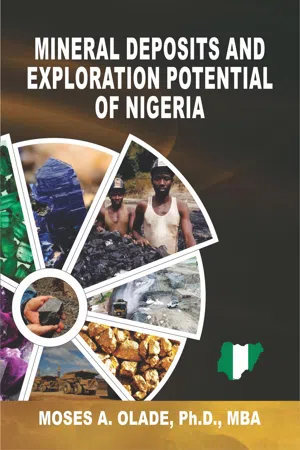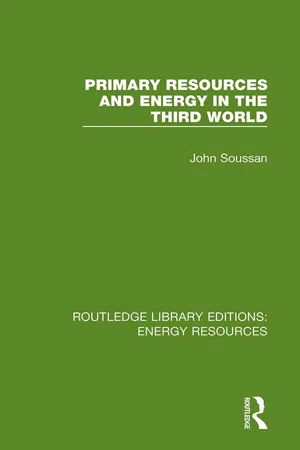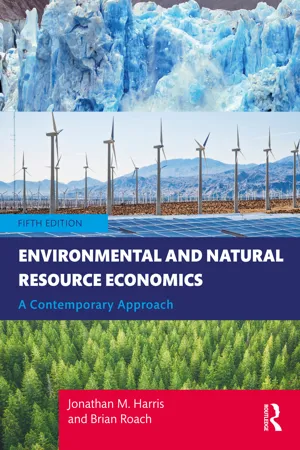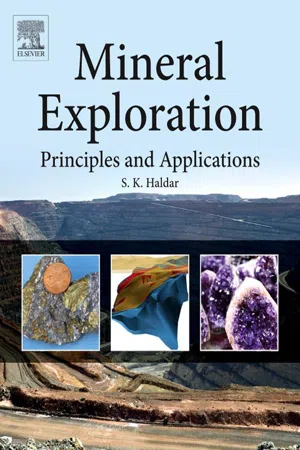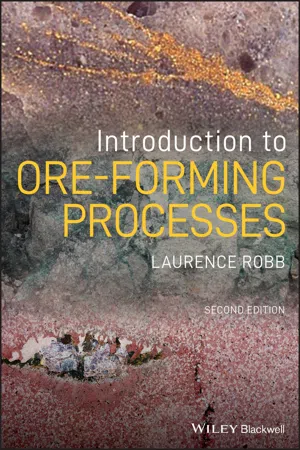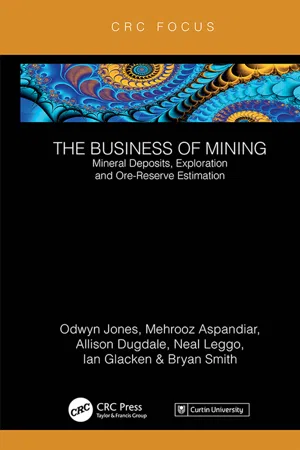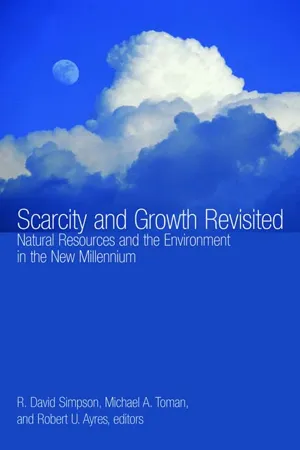Geography
Mineral Reserves
Mineral reserves refer to the economically viable and extractable portion of a mineral deposit. These reserves are estimated based on geological data and economic factors, and they play a crucial role in assessing a country's mineral wealth and potential for mining activities. Understanding mineral reserves is essential for resource management and sustainable development.
Written by Perlego with AI-assistance
Related key terms
Related key terms
1 of 4
Related key terms
1 of 3
8 Key excerpts on "Mineral Reserves"
- Moses A OLADE(Author)
- 2020(Publication Date)
- Prescott Resource Publishers(Publisher)
Chapter 1Introduction to Mineral DepositsDefinition of Terms
Mineral resources are useful earth materials of sufficient quantity and adequate quality to be extracted and used for human benefit. Since time immemorial, economic minerals have been exploited and used as raw materials for industrial production and to generate revenue for the national economy through export to other countries. Mineral resources can be subdivided into two broad groups, according to their form of occurrence: (1) Solid Minerals and (2) Liquid Fuels (petroleum). When solid minerals of economic value are concentrated in the earth’s crust in sufficient quantities to be of extractable, they are described as mineral deposits. Solid mineral deposits can be subdivided into three types: metallic, non-metallic, and energy minerals.The total mineral endowment of a nation or region consists of two major parts: identified resources and undiscovered resources. Identified resources are those resources whose location, grade, quality, and quantity are known or can be estimated from specific geological information. In contrast, undiscovered resources are those whose existence is extrapolated based on broad geological knowledge. Mineral Reserves refer to the portion of an identified mineral resource that can be mined at a profit. Private investment is a major driving force of mineral resource development in a capitalist system, and the desire to extract minerals at a profit becomes a paramount consideration in evaluating expected returns on investment.Mineral resources are unique among other natural resources because they are not only of instant value but also are non-renewable- eBook - ePub
- John Soussan(Author)
- 2019(Publication Date)
- Routledge(Publisher)
This picture makes predicting the future of minerals all sound very straightforward. Unfortunately the story is not that simple. In principle, there is a finite amount of a mineral resource available in the earth’s crust, but in practice the extent of that quantity is a matter of conjecture. This is partly because most of the earth’s crust has not yet been fully explored, measured and inventoried, partly because minerals are not found in nice neat, homogeneous packages, but are rather mixed in with all sorts of other materials and partly because economic and technical constraints limit the proportion of a mineral deposit which can be exploited (the ‘recovery rate’). All of this leads to massive uncertainty over the quantity of the various mineral resources which is likely to be available – they are finite, but how finite?There are three standard definitions of the quantity of a mineral. These definitions measure very different things and are frequently confused. This is particularly true of many of the more pessimistic predictions of the world’s future (the notorious Club of Rome report, The Limits to Growth, is a classic example of this). The definitions are as follows:Proven reserves
These are deposits of a mineral which have been explored, measured and inventoried, and which are both recoverable with current technology and economically viable at current prices. In other words, proven reserves are deposits which we know are there and we know we can get at. For all minerals, proven reserves constitute only a small fraction of the material in the earth’s crust.Resource base
This is the opposite end of the spectrum: an estimate of the total quantity of a given material contained in the earth’s crust. It is a highly theoretical concept which, for many minerals, provides no indication of the quantity which is likely ever to be available to man. For example, on average a cubic kilometre of rock contains 239 million metric tons of aluminium, 149 million metric tons of iron, 62 million metric tons of magnesium, nearly 3 million metric tons of manganese, 239,000 metric tons of zinc, 155,000 metric tons of copper and smaller quantities of many other minerals. The problem is that most of these minerals are normally present at concentrations which are less than a thousandth of those necessary to make their extraction viable. It is only where higher concentrations are found that mining is feasible and the deposits can be considered an ore. Nevertheless the notion of the resource base for minerals does give some indication of the abundance of many supposedly scarce minerals. - eBook - ePub
Environmental and Natural Resource Economics
A Contemporary Approach
- Jonathan M. Harris, Brian Roach(Authors)
- 2021(Publication Date)
- Routledge(Publisher)
Chapter 5 , we considered the allocation of a mineral resource over two periods. We assumed that both the resource quantity and quality were fixed. The economic principles derived from this simple example, including the analysis of user costs for resource pricing, are important, but a more sophisticated analysis must deal with real-world conditions. We usually see many different resource qualities (e.g., different grades of copper ore), and we rarely know with complete certainty the location and total quantity of resource deposits.We first differentiate between the economic reserves of a nonrenewable resource and its physical reserves . The physical supply (in the earth’s crust) is the total amount available, which is finite but generally not precisely known. The economic reserves represent those known reserves that can be extracted profitably based on current prices and technology. Economic reserves provide the measure most commonly used in, for example, calculations of how long a nonrenewable resource might last under assumptions about prices, technology, and depletion rates, referred to as the resource lifetime . Economic reserves change over time for three main reasons:- The resource is extracted and used over time, diminishing reserves.
- New resource deposits are discovered over time, increasing reserves.
- Changing price and technological conditions can make more (or less) of the known reserves economically viable. These factors make predictions of resource lifetimes an inexact science.
A mineral resource such as copper is classified through a combination of geologic and economic measures, as shown in Figure 17.1 .In geological terms, resources are classified in terms of the degree of certainty about the availability of the resource, shown as the horizontal dimension in Figure 17.1 . Identified reserves are those whose quantity and quality are already known, but with varying degrees of confidence. Those identified with the highest degree of confidence are demonstrated reserves , meaning the quantity is generally known with a high degree of certainty. A lower degree of confidence is assigned to inferred reserves , which are estimated based on geological principles but not accurately measured. In addition, hypothetical and speculative reserves - eBook - ePub
Mineral Exploration
Principles and Applications
- Swapan Kumar Haldar(Author)
- 2012(Publication Date)
- Elsevier(Publisher)
Chapter 7 . In situ geological resources are generally higher than minable ore reserves. This is due to availability of detailed sampling input providing higher confidence in estimation, fixing of firm mining boundaries and rejection of mineralization around irregular shapes and tail ends of the body. The firm knowledge of reserves and resources are needed for investment decision of any property.8.1.1 Estimation of Resource and Reserve
The mineral resource and ore reserve potential of mineral deposit is estimated principally by one straightforward formula with minor variation. The unit of measurement is tonne (unit in metric system i.e. 1,000 kg).where,“Influence” of third dimension is the thickness of horizontal deposit like coal seam, bauxite, placer deposits or drill section interval for base metal deposits.t or T = measured quantity in tonne.V = volume in cubic meter (m3 ).A = area in square meter (m2 ) is derived by measurement from plans or sections of the geologically defined mineralized area of the deposit.Sp. Gr. = specific gravity, bulk density and tonnage factor, though not truly synonymous, is used in computation of tonnes by including likely volume of the void and pore spaces. Measurement of number of undisturbed drill cores or bulk samples are the most reliable means of establishing a tonnage factor.8.1.2 Mineral Resource
The mineral resource is the in situ natural concentration or occurrence of mineralization within a geologically defined envelope. The geological characteristics (quantity, grade, and continuity) are partly known, estimated, or interpreted from broad base evidences and regional knowledge. The presence of mineralization is inferred without programmed framework of verification and cutoff concept. The main emphasis is the estimation of resource inventory of low confidence made during early stage of exploration or around the outer periphery of economic concentration. The evidences are based on wide space sampling program discussed at Chapter 7 - eBook - ePub
- Laurence Robb(Author)
- 2020(Publication Date)
- Wiley-Blackwell(Publisher)
Exploration results can be translated into a mineral resource once it is clear that an occurrence of intrinsic economic interest exists in such form and quantity that there are reasonable prospects for its eventual exploitation. Such a resource can only be referred to as an ore reserve if it is a part of an economically extractable measured or indicated mineral resource. One problem with this terminology is that an economically extractable ore deposit in a developing world artisanal operation may not be viable in a technically developed economy, and vice versa. The term “ore deposit” has no significance in the professional description of a mineral occurrence and is best used simply as a descriptive or generic term. Figure 3 Simplified scheme illustrating the conceptual difference between mineral resources and ore reserves as applied to mineral occurrences. The scheme forms the basis for a more unified description of ore deposits as now required in terms of legislation that has been passed in most major mineral producing jurisdictions. Some Useful Definitions and Compilations General Definitions This section is not intended to provide a comprehensive glossary of terms used in this book. There are, however, several terms that are used throughout the text where a definition is either useful or necessary in order to avoid ambiguity. The following definitions are consistent with those provided in the Glossary of Geology (Bates and Jackson 1987) and The Encyclopedia of the Solid Earth Sciences (Kearey 1993). Ore : any naturally occurring material from which a mineral or aggregate of value can be extracted at a profit. In this book the concept extends to coal (a combustible rock comprising more than 50% by weight carbonaceous material) and petroleum (naturally occurring hydrocarbon in gaseous, liquid, or solid state). Syngenetic : refers to ore deposits that form at the same time as their host rocks - eBook - ePub
The Business of Mining
Mineral Deposits, Exploration and Ore-Reserve Estimation (Volume 3)
- Ifan Odwyn Jones, Mehrooz Aspandiar, Allison Dugdale, Neal Leggo, Ian Glacken, Bryan Smith(Authors)
- 2019(Publication Date)
- CRC Press(Publisher)
Mineral resources and ore reserves estimationIntroduction
Estimating mineral resources and ore reserves are among the most important tasks in the economic evaluation of prospective mines or the proposed extension of existing operations (Appleyard, 2001).The 2012 JORC Code defines a mineral resource as‘a concentration or occurrence of solid material of economic interest in or on the Earth’s crust in such form, grade (or quality), and quantity that there are reasonable prospects for eventual economic extraction. The location, quantity, grade (or quality), continuity and other geological characteristics of a Mineral Resource are known, estimated or interpreted from specific geological evidence and knowledge, including sampling. Mineral Resources are sub-divided, in order of increasing geological confidence, into Inferred, Indicated and Measured categories’. (See Chapter 4 for details of the JORC Code etc.)For indicated mineral resources, sample specimens and testing are too sparse to confirm geological and/or grade continuity, although their proximity is such that continuity can be assumed. A measured mineral resource, on the other hand, must have sample specimens sufficiently close to confirm geological and/or grade continuity. It follows, therefore, that tonnages, densities, shape, physical characteristics, grade and mineral content can be estimated with a reasonable level of confidence for indicated mineral resources and with a high level of confidence for measured mineral resources. The JORC Code states that only the higher categories of mineral resources can be used in evaluations of economic viability; inferred resources may not. It also states that the choice of category depends on the quality, quantity and distribution of the available data and is a decision to be taken by the Competent Person or Persons. The Competent Person must be an appropriately qualified and experienced geologist and a member of either the Australian Institute of Geoscientists or the Australasian Institute of Mining and Metallurgy. - eBook - ePub
Scarcity and Growth Revisited
Natural Resources and the Environment in the New Millenium
- R. David Professor Simpson, Michael A. Professor Toman, Robert U. Professor Ayres, R. David Professor Simpson, Michael A. Professor Toman, Robert U. Professor Ayres(Authors)
- 2012(Publication Date)
- Routledge(Publisher)
Nevertheless, societies’ dependence upon minerals has resulted in periodic concern about the adequacy of mineral supplies to continue to support the economy. This concern has been rooted in experiences as diverse as shortages of minerals in wartime, depletion of individual mineral deposits and even mining districts (Hewett 1929), and rapid increases in mineral consumption when countries industrialize. These experiences have sparked periodic debates about the abundance or scarcity of mineral resources.Addressing such questions has been particularly difficult because the concept of a mineral resource involves both geologic and economic aspects and because knowledge about the earth and future economic conditions is limited. On the one hand, mineral deposits are physical entities that form as the result of geologic processes and are therefore finite and exhaustible. On the other hand, the amount of a mineral commodity that will be produced in the future is dependent on future costs of discovering and processing new mineral deposits, recycling used materials, and developing substitute materials (Tilton 1996). Many debates about mineral scarcity have taken place because participants did not appreciate both the physical and economic aspects of mineral resources.The debates about the adequacy of future mineral supplies that took place in the 1970s illustrate this lack of understanding. The twentieth century was an era of unprecedented metal availability due to geologic and economic circumstances. The settlement of Australia, Canada, and the western United States, and colonial-era mineral exploration in Africa in the second half of the nineteenth century, led to the discovery of an unprecedented number of mineral deposits that provided abundant, high-quality minerals throughout the twentieth century. In addition, innovations in mining, such as Daniel jackling's recognition that low-grade porphyry copper ores could be profitably mined by using economies of scale, as well as innovations in mineral processing and metallurgy, have reduced the cost of producing metals and added to the inventory of very large deposits that can be profitably processed. Further, advances in information processing and search technologies used in mineral exploration, including the widespread application of geophysical tools, geochemical methods, satellite imaging, and mineral deposit models, increased the efficiency of mineral exploration. - eBook - ePub
- Laurence Robb(Author)
- 2013(Publication Date)
- Wiley-Blackwell(Publisher)
Introduction: mineral resourcesTOPICSGENERAL INTRODUCTION AND AIMS OF THE BOOKA SIMPLE CLASSIFICATION SCHEME FOR MINERAL DEPOSITSSOME IMPORTANT DEFINITIONSmetallogeny, syngenetic, epigenetic, mesothermal, epithermal, supergene, hypogene, etc.SOME RELEVANT COMPILATIONSperiodic table of the elements tables of the main ore and gangue minerals geological time scaleFACTORS THAT MAKE A VIABLE MINERAL DEPOSITenrichment factors required to make ore deposits how are mineral resources and ore reserves defined?NATURAL RESOURCES AND THEIR FUTURE EXPLOITATIONsustainability environmental responsibilityINTRODUCTION AND AIMS
Given the unprecedented growth of human population over the past century, as well as the related increase in demand for and production of natural resources, it is evident that understanding the nature, origin and distribution of the world’s mineral deposits remains a strategic topic. The discipline of “economic geology,” which covers all aspects pertaining to the description and understanding of mineral resources, is, therefore, one which traditionally has been, and should remain, a core component of the university earth science curriculum. It is also the discipline that underpins the training of professional earth scientists working in the minerals and related industries of the world. A tendency in the past has been to treat economic geology as a vocational topic and to provide instruction only to those individuals who wished to specialize in the discipline or to follow a career in the minerals industry. In more recent years, changes in earth science curricula have resulted in a trend, at least in a good many parts of the world, in which economic geology has been sidelined.The conceptual development of earth systems science, also a feature of the latter years of the twentieth century, has led to dramatic shifts in the way in which the earth sciences are taught. A more holistic, process-orientated approach has led to a much wider appreciation of the Earth as a complex interrelated system. The understanding of feedback mechanisms has brought an appreciation that the solid Earth, its oceans and atmosphere, and the organic life forms that occupy niches above, at and below its surface, are intimately connected and can only be understood properly in terms of an interplay of processes. Examples include the links between global tectonics and climate patterns, and also between the evolution of unicellular organisms and the formation of certain types of ore deposits. In this context the teaching of many of the traditional geological disciplines assumes new relevance and the challenge to successfully teaching earth system science is how best to integrate the wide range of topics into a curriculum that provides understanding of the entity. Teaching the processes involved in the formation of the enormously diverse ore deposit types found on Earth is necessary, not only because of its practical relevance to the real world, but also because such processes form an integral and informative part of the Earth’s evolution.
Index pages curate the most relevant extracts from our library of academic textbooks. They’ve been created using an in-house natural language model (NLM), each adding context and meaning to key research topics.
Explore more topic indexes
Explore more topic indexes
1 of 6
Explore more topic indexes
1 of 4
